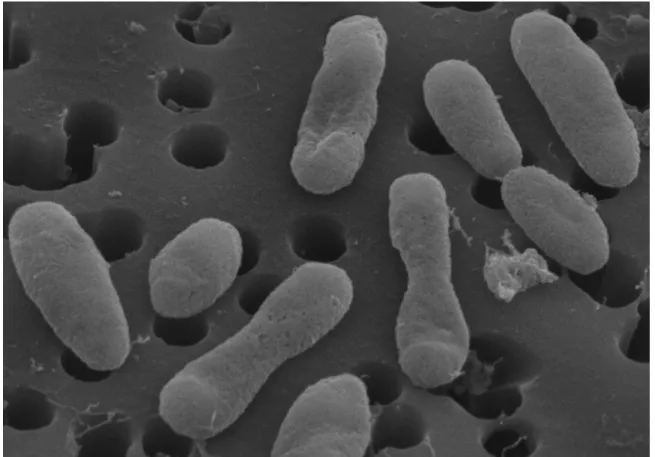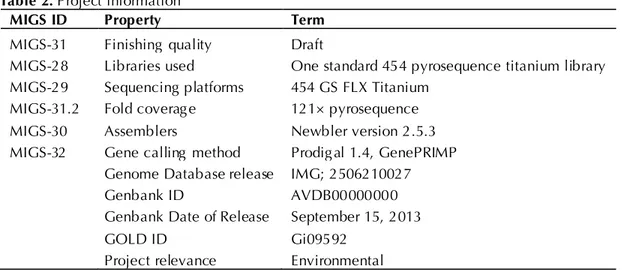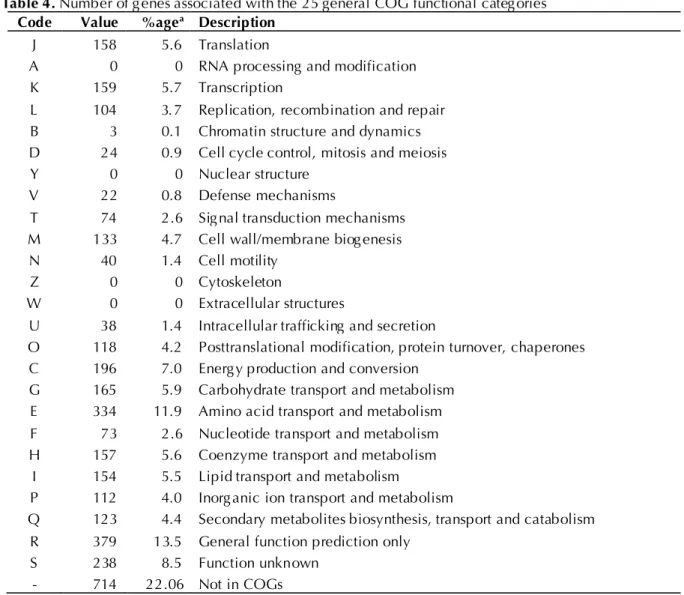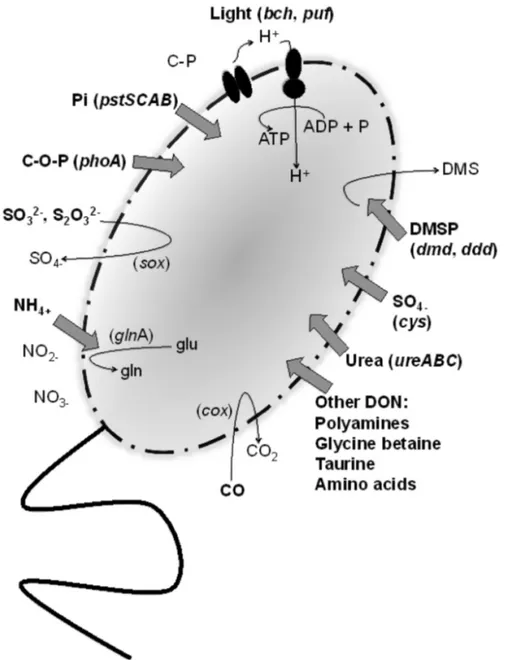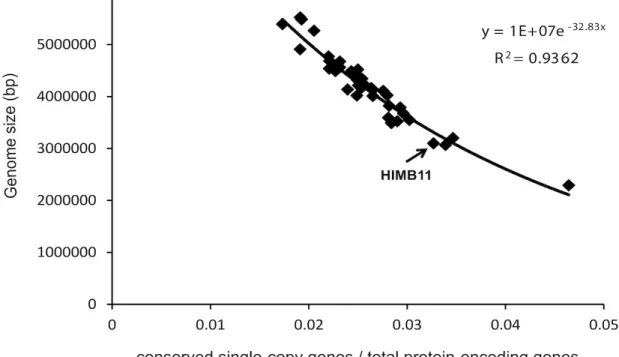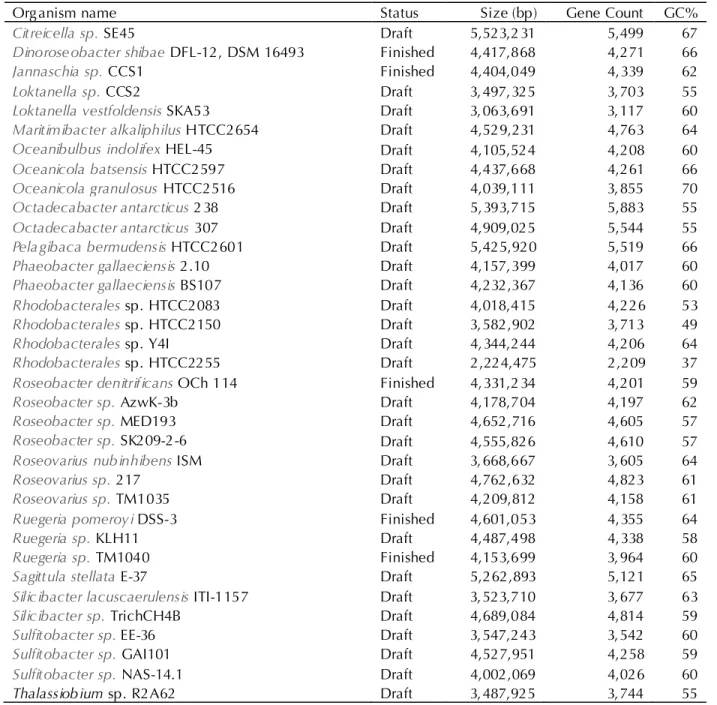Draft genome sequence of marine alphaproteobacterial
strain HIMB11, the first cultivated representative
of a unique lineage within the Roseobacter
clade possessing an unusually small genome
The MIT Faculty has made this article openly available.
Please share
how this access benefits you. Your story matters.
Citation
Durham, Bryndan P., Jana Grote, Kerry A. Whittaker, Sara J. Bender,
Haiwei Luo, Sharon L. Grim, Julia M. Brown, et al. “Draft Genome
Sequence of Marine Alphaproteobacterial Strain HIMB11, the
First Cultivated Representative of a Unique Lineage Within the
Roseobacter Clade Possessing an Unusually Small Genome.” Stand.
Genomic Sci. 9, no. 3 (March 15, 2014): 632–645.
As Published
http://dx.doi.org/10.4056/sigs.4998989
Publisher
Genomic Standards Consortium
Version
Final published version
Citable link
http://hdl.handle.net/1721.1/101419
Terms of Use
Creative Commons Attribution
The Genomic Standards Consortium
Draft genome sequence of marine alphaproteobacterial strain HIMB11,
the first cultivated representative of a unique lineage within the
Roseobacter
clade possessing an unusually small genome
Bryndan P. Durham1,2, Jana Grote1,3, Kerry A. Whittaker1,4, Sara J. Bender1,5, Haiwei Luo6, Sharon L.
Grim1,7, Julia M. Brown1,8, John R. Casey1,3, Antony Dron1,9, Lennin Florez-Leiva1,10, Andreas Krupke1,11,
Catherine M. Luria1,12, Aric H. Mine1,13, Olivia D. Nigro1,3, Santhiska Pather1,14, Ag athe Talarmin1,15,
Emma K. Wear1,16, Thomas S. Weber1,17, Jesse M. Wilson1,18, Matthew J. Church1,3, Edward F.
DeLong1,19, David M. Karl1,3, Grieg F. Steward1,3, John M. Eppley1,19, Nikos C. Kyrpides1,20, Stephan
Schuster1, and Michael S. Rappé1*
1 Center for Microbial Oceanography: Research and Education, University of Hawaii, Honolulu, Hawaii, USA
2 Department of Microbiology, University of Georgia, Athens, Georgia, USA 3 Department of Oceanography, University of Hawaii, Honolulu, Hawaii, USA
4 Graduate School of Oceanography, University of Rhode Island, Narragansett, Rhode Island, USA 5 School of Oceanography, University of Washington, Seattle, Washington, USA
6 Department of Marine Sciences, University of Georgia, Athens, Georgia, USA 7 Marine Biological Laboratory, Woods Hole, Massachusetts, USA
8 Department of Microbiology, Cornell University, Ithaca, New York, USA 9 Observatoire Océanologique de Villefranche, Villefranche-sur-mer, France 1 Universidad Del Magdalena, Santa Marta, Colombia
1 Max Plank Institute for Marine Microbiology, Bremen, Germany
12 Department of Ecology and Evolutionary Biology, Brown University, Providence, Rhode Island,
USA
13 Department of Geophysical Sciences, University of Chicago, Chicago, Illinois, USA
14 School for Marine Science and Technology, University of Massachusetts Dartmouth, Dartmouth,
Massachusetts, USA
15 Department of Earth System Science, University of California Irvine, Irvine, CA, USA
16 Marine Science Institute, University of California Santa Barbara, Santa Barbara, California, USA 17 Department of Atmospheric and Ocean Sciences, University of California Los Angeles, Los
Ange-les, California, USA
18 School of Natural Sciences, University of California Merced, Merced, California, USA 19 Department of Civil and Environmental Engineering, Massachusetts Institute of Technology,
Cambridge, Massachusetts, USA
20 Department of Energy Joint Genome Institute, Walnut Creek, California, USA
*Correspondence: Michael S. Rappé (rappe@hawaii.edu)
Keywords: marine bacterioplankton, Roseobacter, aerobic anoxygenic phototroph, dimethylsulfoniopropionate
Strain HIMB11 is a planktonic marine bacterium isolated from coastal seawater in Kaneohe Bay, Oahu, Hawaii belonging to the ubiquitous and versatile Roseobacter clade of the alphaproteobacterial family
Rhodobacteraceae. Here we describe the preliminary characteristics of strain HIMB11, including annota-tion of the draft genome sequence and comparative genomic analysis with other members of the
Roseobacter lineage. The 3,098,747 bp draft genome is arranged in 34 contigs and contains 3,183 pro-tein-coding genes and 54 RNA genes. Phylogenomic and 16S rRNA gene analyses indicate that HIMB11 represents a unique sublineage within the Roseobacter clade. Comparison with other publicly available genome sequences from members of the Roseobacter lineage reveals that strain HIMB11 has the genomic potential to utilize a wide variety of energy sources (e.g. organic matter, reduced inorganic sulfur, light, carbon monoxide), while possessing a reduced number of substrate transporters.
Abbreviations: DMSP - Dimethylsulfoniopropionate, DMS - dimethylsulfide, AAnP - aerobic anoxygenic phototroph, COG - Clusters of Orthologous Groups, PGC -photosynthesis gene cluster, BLUF - blue-light using flavin adenine nucleotide, ABC - ATP-binding cassette, TRAP - tripartite ATP-independent
Introduction
Bacteria belonging to the
Roseobacter
lineage of
marine
Alphaproteobacteria
account for a
sub-stantial fraction (ranging ~10 – 25%) of
bacterioplankton cells in surface ocean seawater
[1-4], making them one of a relatively small
number of suitable targets for scientists
investi-gating the ecology of abundant marine bacterial
groups. Focused genome sequencing efforts have
provided significant insights into the functional
and ecological roles for this group [5-7]. In 2004,
the first member of this group to have its genome
sequenced,
Ruegeria pomeroyi
(basonym
Silicibacter pomeroyi
) strain DSS-3 [8], revealed
strategies used by the
Roseobacter
group for
nu-trient acquisition in the marine environment. To
date, over 40 genomes have been sequenced
from members of the
Roseobacter
lineage.
Com-parative analysis among 32 of these genomes
in-dicates that members of this group are ecological
generalists, having relatively plastic
require-ments for carbon and energy metabolism, which
may allow them to respond to a diverse range of
environmental conditions [9]. For example,
members of the
Roseobacter
lineage have the
ge-nomic potential to obtain energy via oxidation of
organic substrates, oxidation of inorganic
com-pounds, and/or sunlight-driven electron transfer
via bacteriochlorophyll a, proteorhodopsin, or
xanthorhodopsin phototrophic systems. Genome
analyses as well as culture experiments have also
revealed a variety of mechanisms by which
roseobacters may associate and interact with
phytoplankton and other eukaryotes. These
in-clude genes involved in uptake of compounds
produced by algae such as peptides, amino acids,
putrescine, spermidine, and DMSP [10,11], as
well as genes for chemotaxis, attachment, and
secretion [12].
Strain HIMB11 was isolated from surface
sea-water collected from Kaneohe Bay off the coast of
Oahu, Hawaii, USA in May, 2005. Subsequent 16S
rRNA gene sequence comparisons revealed it to
be a member of the
Roseobacter
clade of marine
bacterioplankton [13] that was highly abundant
after a storm-induced phytoplankton bloom in the
bay [14]. Here, we present a preliminary set of
features for strain HIMB11, a description of the
draft genome sequence and annotation, and a
comparative analysis with 35 other genome
se-quences from members of the
Roseobacter
lineage.
Genome annotation revealed strain HIMB11 to
have the genetic potential for
bacteriochlorophyll-based aerobic anoxygenic phototrophic (AAnP)
metabolism and degradation of the algal-derived
compound DMSP along with production of the
climate-relevant gas dimethylsulfide (DMS), and
oxidation of the greenhouse gas carbon monoxide
(CO). Collectively, these features indicate the
po-tential for strain HIMB11 to participate in the
bio-geochemical cycling of sulfur and carbon, and
con-comitantly affect global climate processes.
Classification and features
Strain HIMB11 was isolated by a high-throughput,
dilution-to-extinction approach [15] from surface
seawater collected near the coast of Oahu, Hawaii,
USA, in the tropical North Pacific Ocean. The strain
was isolated in seawater sterilized by tangential
flow filtration and amended with low
concentra-tions of inorganic nitrogen and phosphorus (1.0
µM NH4Cl, 1.0 µM NaNO3, and 0.1 µM KH
2PO4).Comparative analysis of the HIMB11 16S rRNA
gene sequence to those from cultured, sequenced
roseobacters indicates that HIMB11 occupies a
unique lineage that is divergent from the 16S
rRNA gene sequences of
Roseobacter
strains
al-ready in culture (Figure 1). Based on the National
Center for Biotechnology Information (NCBI)
non-redundant database, the HIMB11 16S rRNA
gene sequence is most similar (~99% nucleotide
identity) to a large number of environmental
gene clones obtained from various marine
envi-ronments that exclusively fall in the
Roseobacter
lineage of
Alphaproteobacteria
.
Because of the significant sequence variation in
16S rRNA genes (up to 11%) and the prevalence
of horizontal gene transfer within the clade,
estab-lishing a taxonomic framework for roseobacters
remains a challenge [9]. When genome sequence
data is available, it is often more informative to
perform a phylogenomic analysis based on shared
orthologs versus 16S rRNA phylogenetic analysis
alone [9,21]. A maximum likelihood tree
con-structed using 719 shared orthologous protein
sequences supported the 16S rRNA gene-based
analysis by revealing that HIMB11 formed a
unique sublineage of the
Roseobacter
clade
(Fig-ure 2).
Figure 1. Phylogenetic relationships between HIMB11 and bacterial strains belonging to the
Roseobacter clade. SSU rRNA gene sequences were aligned with version 111 of the ‘All-Species Living Tree’ project SSU rRNA gene database [16] using the ARB software package [17]. The phy-logeny was constructed from nearly full-length gene sequences using the RAxML maximum likeli-hood method [18] within ARB, filtered to exclude alignment positions that contained gaps or am-biguous nucleotides in any of the sequences included in the tree. Bootstrap analyses were deter-mined by RAxML [19] via the raxmlGUI graphical front end [20]. The scale bar corresponds to 0.05 substitutions per nucleotide position. Open circles indicate nodes with bootstrap support be-tween 50-80%, while closed circles indicate bootstrap support >80%, from 500 replicates. A varie-ty of Archaea were used as outgroups.
HIMB11 cells are short, irregular rods (0.3-0.5 x
0.8 µm) that are generally smaller in size than
previously reported for other cultured
Roseobacter
strains (e.g. described taxa in
Bergey’s Manual range from 0.5-1.6 – 1.0-4.0 µm)
[24] (Figure 3). HIMB11 is likely motile, as the
genes necessary to build flagella are present (e.g.
fli, flg). Based on the ability of HIMB11 to grow in
dark or light on a medium consisting solely of
sterile seawater amended with inorganic nitrogen
and phosphorus, and the absence any of the
known pathways for inorganic carbon fixation, the
strain is presumed to acquire carbon and energy
via the oxidation of components of the dissolved
organic carbon pool in natural seawater. Based on
the presence of carbon-monoxide-oxidizing genes
(i.e. coxL, forms I and II) [25,26] as well as
bacteriochlorophyll-based phototrophy genes (e.g.
puf, puh, bch) [27,28], HIMB11 is hypothesized to
oxidize both organic and inorganic compounds as
well as obtain energy from light [5]. A summary of
these and other features is shown in Table 1.
Table 1. Classification and general features of strain HIMB11 according to the MIGS rec-ommendations [
29
].MIGS ID Property Term Evidence codea
Domain Bacteria TAS [30]
Phylum Proteobacteria TAS [31] Class Alphaproteobacteria TAS [32,33] Current classification Order Rhodobacterales TAS [32,34] Family Rhodobacteraceae TAS [32,35] Genus not assigned
Species not assigned Strain HIMB11
Gram stain Negative NAS
Cell shape Short irregular rods IDA
Motility Flagella NAS
Sporulation Non-sporulating NAS
Temperature range Mesophile IDA
Optimum temperature Unknown
Carbon source Ambient seawater DOC TAS [36]
Energy source Mixotrophic NAS
Terminal electron receptor
MIGS-6 Habitat Seawater IDA
MIGS-6.3 Salinity ~35.0 ‰ IDA
MIGS-22 Oxygen Aerobic NAS
MIGS-15 Biotic relationship Free-living TAS [36]
MIGS-14 Pathogenicity None NAS
MIGS-4 Geographic location Kaneohe Bay, Hawaii TAS [14]
MIGS-5 Sample collection time 18 May, 2005 TAS [14]
MIGS-4.1 Latitude - Longitude 21.44, -157.78 TAS [14]
MIGS-4.2
MIGS-4.3 Depth ~1 m TAS [14]
MIGS-4.4 Altitude
a) Evidence codes - IDA: Inferred from Direct Assay; TAS: Traceable Author Statement (i.e., a direct report exists in the literature); NAS: Non-traceable Author Statement (i.e., not di-rectly observed for the living, isolated sample, but based on a generally accepted property for the species, or anecdotal evidence). These evidence codes are from the Gene Ontology project [37].
Figure 3. Scanning electron micrograph of strain HIMB11. For scale, the membrane pore
size is 0.2 μm in diameter.
Genome sequencing information
Genome project history
The genome of strain HIMB11 was selected for
sequencing based on its phylogenetic affiliation
with the widespread and ecologically important
Roseobacter
clade of marine bacterioplankton and
its periodically high abundance in coastal Hawaii
seawater [14]. The genome sequence was
com-pleted on May 25, 2011, and presented for public
access on September 15, 2013. The genome
pro-ject is deposited in the Genomes OnLine Database
(GOLD) as project Gi09592. The Whole Genome
Shotgun project has been deposited at
DDBJ/EMBL/GenBank under the accession
num-ber AVDB00000000. The version described in this
paper is version AVBD01000000. Table 2 presents
the main project information and its association
with MIGS version 2.0 compliance [29].
Growth conditions and DNA isolation
Strain HIMB11 was grown at 27 °C in 60 L of
coastal Hawaii seawater sterilized by tangential
flow filtration and supplemented with 10 µM
NH4Cl, 1.0 µM KH2PO4, and 1.0 µM NaNO3 (final
concentrations). Cells from the liquid culture were
collected on a membrane filter, and DNA was
iso-lated using a standard
phe-nol/chloroform/isoamyl alcohol extraction
proto-col. A total of 50 μg of DNA was obtained.
Genome sequencing and assembly
The HIMB11 genome was sequenced at the
Penn-sylvania State University Center for Comparative
Genomics and Bioinformatics (University Park, PA,
USA) using a 454 GS FLX platform and Titanium
chemistry from 454 Life Sciences (Branford, CT,
USA). The sequencing library was prepared in
ac-cordance with 454 instructions and was carried
out on a full 454 picotiter plate. This yielded
1,550,788 reads with an average length of 359 bp,
totaling 556,821,617 bp. A subset of 1,336,895
reads was ultimately assembled using the
Newbler assembler version 2.5.3, yielding a final
draft genome of 34 contigs representing
3,098,747 bp. This provided 121× coverage of the
genome.
Table 2. Project information
MIGS ID Property Term
MIGS-31 Finishing quality Draft
MIGS-28 Libraries used One standard 454 pyrosequence titanium library MIGS-29 Sequencing platforms 454 GS FLX Titanium
MIGS-31.2 Fold coverage 121× pyrosequence
MIGS-30 Assemblers Newbler version 2.5.3
MIGS-32 Gene calling method Prodigal 1.4, GenePRIMP Genome Database release IMG; 2506210027
Genbank ID AVDB00000000
Genbank Date of Release September 15, 2013
GOLD ID Gi09592
Project relevance Environmental
Genome annotation
Genes were identified using Prodigal 1.4 [38] as
part of the genome annotation pipeline in the
In-tegrated Microbial Genomes Expert Review
(IMG-ER) system [39,40] developed by the Joint
Ge-nome Institute (Walnut Creek, CA, USA). Predicted
coding sequences were translated and used as
queries against the NCBI non-redundant database
and UniProt, TIGRFam, Pfam, PRIAM, KEGG, COG,
and InterPro databases. The tRNAScanSE tool [41]
was used to identify tRNA genes, and ribosomal
RNAs were identified using RNAmmer [42]. Other
non-coding RNAs were found by searching the
genome for corresponding Rfam profiles using
INFERNAL [43]. Additional gene prediction
analysis and manual functional annotation was
performed within the IMG-ER platform.
Genome properties
The HIMB11 draft genome is 3,098,747 bp long
and comprises 34 contigs ranging in size from 454
to 442,822 bp, with an overall GC content of
49.73% (Table 3). Of the 3,237 predicted genes,
3,183 (98.33%) were protein-coding genes, and
54 were RNAs. Most (78%) protein-coding genes
were assigned putative functions, while the
re-maining genes were annotated as hypothetical
proteins. The distribution of genes into COG
func-tional categories is presented in Table 4.
Table 3. Nucleotide content and gene count levels of the genome
Attribute Value % of totala
Genome size (bp) 3,098,747 100.00
DNA coding region (bp) 2,812,982 90.78
DNA G+C content (bp) 1,541,077 49.73
Total genes 3,2 37 100.00
RNA genes 54 1.67
Protein-coding genes 3,183 98.33
Genes in paralog clusters
Genes assigned to COGs 2,523 77.94
1 or more conserved domains 2 or more conserved domains 3 or more conserved domains 4 or more conserved domains
Genes with signal peptides 919 28.39
Genes with transmembrane helices 654 20.20 Paralogous groups
a) The total is based on either the size of the genome in base pairs or the total number of protein coding genes in the annotated genome.
Table 4. Number of genes associated with the 25 general COG functional categories Code Value %agea Description
J 158 5.6 Translation
A 0 0 RNA processing and modification
K 159 5.7 Transcription
L 104 3.7 Replication, recombination and repair B 3 0.1 Chromatin structure and dynamics D 24 0.9 Cell cycle control, mitosis and meiosis
Y 0 0 Nuclear structure
V 22 0.8 Defense mechanisms
T 74 2.6 Signal transduction mechanisms M 133 4.7 Cell wall/membrane biogenesis
N 40 1.4 Cell motility
Z 0 0 Cytoskeleton
W 0 0 Extracellular structures
U 38 1.4 Intracellular trafficking and secretion
O 118 4.2 Posttranslational modification, protein turnover, chaperones C 196 7.0 Energy production and conversion
G 165 5.9 Carbohydrate transport and metabolism E 334 11.9 Amino acid transport and metabolism F 73 2.6 Nucleotide transport and metabolism H 157 5.6 Coenzyme transport and metabolism
I 154 5.5 Lipid transport and metabolism
P 112 4.0 Inorganic ion transport and metabolism
Q 123 4.4 Secondary metabolites biosynthesis, transport and catabolism R 379 13.5 General function prediction only
S 238 8.5 Function unknown
- 714 22.06 Not in COGs
a) The total is based on the total number of protein coding genes in the annotated genome.
Insights from the Genome Sequence
Metabolism of HIMB11
Major pathways of carbon, nitrogen, phosphorus,
and sulfur acquisition, as well as alternative
me-tabolisms and means of energy acquisition (e.g.
light, CO), were annotated based on the presence
and absence of key genes involved in these
pro-cesses. A summary is provided in Figure 4.
HIMB11 appears to possess an incomplete
glycol-ysis pathway (pfkC and pgm are absent), yet it
possesses the genes necessary for
gluconeogene-sis. HIMB11 harbors genes for the
Entner-Doudoroff and pentose phosphate pathways, as
well as pyruvate carboxylase to perform
anaplerotic CO2 fixation. HIMB11 does not appear
to use inorganic forms of nitrogen other than
am-monium, as there are no genes present that are
involved in nitrogen fixation, nitrate or nitrite
reduction, nitric oxide reduction, nitrous oxide
reduction, hydroxylamine oxidation, or
nitroalkane denitrification. Instead, HIMB11 is
hypothesized to rely solely on reduced and
organ-ic nitrogen sources; there are transporters for
ammonium (amtB) and a variety of other
nitro-gen-containing substrates (e.g. amino acids,
poly-amines, glycine betaine, taurine), as well as genes
for urease (ureABC). Strain HIMB11 possesses a
high-affinity phosphate transporter accompanied
by regulatory genes (pstSCAB, phoUBR) and
alka-line phosphatase (phoA), suggesting that it can
utilize both inorganic and organic forms of
phos-phorus; it does not harbor low-affinity phosphate
transport (pitA) or the genes for phosphonate
uti-lization (phnGHIJKLM).
Figure 4. Proposed mechanisms for the acquisition of carbon, nitrogen, phospho-rus, sulfur, and energy in HIMB11. Substrates that are hypothesized to be trans-ported and used by HIMB11 are in bold. Genes that designate these mechanisms are indicated. DMSP, dimethylsulfoniopropionate; DMS, dimethylsulfide; DON, dissolved organic nitrogen; C-O-P, phosphoesters; C-P, phosphonates; Pi, phos-phate.
HIMB11 possesses genes for assimilatory sulfate
reduction (cys) and for the metabolism of reduced,
organic sulfur compounds (e.g. amino acids,
DMSP). DMSP is an osmolyte produced by certain
phytoplankton, including dinoflagellates and
coccolithophores [44,45], and acts as a major
source of both carbon and sulfur for marine
bacterioplankton in ocean surface waters [46-49].
Roseobacters are frequently abundant during
DMSP-producing algal blooms [1], and members
of this group have become models for the study of
bacterial transformations of DMSP [50]. There are
two competing pathways for DMSP degradation:
the demethylation pathway that leads to
assimila-tion of sulfur (dmdA, -B, -C, -D), and the cleavage
pathway that leads to the release of DMS (dddD,
-L, -P, -Q, -W, -Y) [51]. DMS is a climate-active gas
that has been implicated in the formation of
at-mospheric-cooling aerosols and clouds. The
ge-nome of HIMB11 harbors versions of both sides of
the pathway (dmdA, -B, -C, -D’ and dddP, -D).
The HIMB11 genome contains genes that encode
for a diverse array of energy acquisition strategies.
The presence of the sox gene cluster indicates that
HIMB11 is putatively capable of oxidizing reduced
inorganic sulfur compounds [8] as a mechanism for
lithoheterotrophic growth. Additional modes of
energy acquisition encoded by the HIMB11 genome
include pathways for CO oxidation to CO
2via
car-bon monoxide dehydrogenase (i.e. cox operons,
including coxL, forms I and II) [25,26], degradation
of aromatics (i.e. gentisate, benzoate, phenylacetic
acid), and bacteriochlorophyll-based anoxygenic
photosynthesis. Photosynthetic genes are
orga-nized in a photosynthesis gene cluster (PGC) and
include genes for the photosynthetic reaction
cen-ter (puf and puh), light harvesting complexes,
bio-synthesis of bacteriochlorphyll a and carotenoids,
and regulatory factors (bch and crt). Two
con-served regions within the PGC that were identified
in a recent study examining the structure and
ar-rangement of PGCs in ten AAnP bacterial genomes
of different phylogenies, bchFNBHLM-LhaA-puhABC
and crtF-bchCXYZ [28], were also found to be
con-served in the HIMB11 genome. The arrangement of
the puf genes (pufQBALMC) as well as the puh genes
(puhABC-hyp-ascF-puhE) in HIMB11 is very similar
to what has been described before for other
Roseobacter
strains [28]. Putative genes containing
the sensor domain BLUF (blue-light-utilizing flavin
adenine dinucleotide) were also found in HIMB11.
BLUF sensor domains have been hypothesized to
be involved in a light-dependent regulation of the
photosynthesis operon and may enable light
sens-ing for phototrophy [5,52].
Genome comparisons with other
members of the
Roseobacter
clade
A regression model was used to estimate the
ge-nome size of HIMB11 based on the gege-nomes of 40
Roseobacter
strains (Figure 5). The model considers
the number of nucleotides sequenced versus the
ra-tio of the number of conserved single-copy genes
universally present in
Roseobacter
genomes to the
number of predicted protein-encoding genes. These
data were fit to an exponential regression model
(R
2=0.94), which estimates the genome coverage of
the draft HIMB11 genome to be 90.6% and the full
genome size to be 3.42 Mb. This is relatively small
compared to most cultured
Roseobacter
genomes
(median 4.35 Mb) with only one notable exception
(
Roseobacter
member HTCC2255, 2.21 Mb).
Figure 5. Regression model for strain HIMB11 genome size estimation based on the genomes of 40 cul-tured Roseobacter strains. The x-axis shows the ratio of the number of conserved single-copy genes univer-sally present in fully sequenced Roseobacter genomes to the number of predicted protein-encoding genes. The y-axis is the number of nucleotides sequenced. The data were fit to an exponential regression model (R2=0.94), and the model was used to estimate the genome size of HIMB11 to be 3.42 Mb.
At the time of this analysis, 35 other
Roseobacter
genomes were publically available in the IMG-ER
database (Table 5). The effect of a reduced genome
size is readily apparent with respect to the
trans-porter content of the HIMB11 genome: it possesses a
highly reduced number of genes devoted to
ATP-binding cassette (ABC) transporters and tripartite
ATP-independent periplasmic (TRAP) transporters.
ABC transporters use energy from ATP hydrolysis to
transport a wide range of substrates across the
membrane (e.g. ions, amino acids, peptides, sugars).
While the 35 public
Roseobacter
genomes contain on
average 279 genes involved in ABC transport (171
to 443 per genome), HIMB11 has only 169 genes for
ABC transport systems. TRAP transporters are also
underrepresented in the HIMB11 genome. These are
a large prokaryotic family of solute transporters that
contain a substrate binding protein (DctP) and two
membrane proteins (DctQ and DctM). By relying on
electrochemical ion gradients rather than ATP for
transport [53], they mediate the uptake of a number
of different substrates (e.g. succinate, malate,
fumarate, pyruvate, taurine, ectoine, DMSP).
Roseobacter
genomes contain on average 60 genes
devoted to TRAP transporter systems (23 to 135
genes per genome), while the HIMB11 genome
har-bors 26 TRAP transporter genes.
Table 5. Publicly available Roseobacter clade genomes use for comparative analysis with strain HIMB11, as of IMG release 3.4.
Organism name Status Size (bp) Gene Count GC%
Citreicella sp. SE45 Draft 5,523,2 31 5,499 67
Dinoroseobacter shibae DFL-12, DSM 16493 Finished 4,417,868 4,271 66
Jannaschia sp. CCS1 Finished 4,404,049 4,339 62
Loktanella sp. CCS2 Draft 3,497,325 3,703 55
Loktanella vestfoldensis SKA53 Draft 3,063,691 3,117 60
Maritimibacter alkaliphilus HTCC2654 Draft 4,529,231 4,763 64
Oceanibulbus indolifex HEL-45 Draft 4,105,524 4,208 60
Oceanicola batsensis HTCC2597 Draft 4,437,668 4,261 66
Oceanicola granulosus HTCC2516 Draft 4,039,111 3,855 70
Octadecabacter antarcticus 2 38 Draft 5,393,715 5,883 55
Octadecabacter antarcticus 307 Draft 4,909,025 5,544 55
Pelagibaca bermudensis HTCC2601 Draft 5,425,920 5,519 66
Phaeobacter gallaeciensis 2.10 Draft 4,157,399 4,017 60
Phaeobacter gallaeciensis BS107 Draft 4,232,367 4,136 60
Rhodobacterales sp. HTCC2083 Draft 4,018,415 4,226 53
Rhodobacterales sp. HTCC2150 Draft 3,582,902 3,713 49
Rhodobacterales sp. Y4I Draft 4,344,244 4,206 64
Rhodobacterales sp. HTCC2255 Draft 2,224,475 2,209 37
Roseobacter denitrificans OCh 114 Finished 4,331,2 34 4,201 59
Roseobacter sp. AzwK-3b Draft 4,178,704 4,197 62
Roseobacter sp. MED193 Draft 4,652,716 4,605 57
Roseobacter sp. SK209-2-6 Draft 4,555,826 4,610 57
Roseovarius nubinhibens ISM Draft 3,668,667 3,605 64
Roseovarius sp. 217 Draft 4,762,632 4,823 61
Roseovarius sp. TM1035 Draft 4,209,812 4,158 61
Ruegeria pomeroyi DSS-3 Finished 4,601,053 4,355 64
Ruegeria sp. KLH11 Draft 4,487,498 4,338 58
Ruegeria sp. TM1040 Finished 4,153,699 3,964 60
Sagittula stellata E-37 Draft 5,262,893 5,121 65
Silicibacter lacuscaerulensis ITI-1157 Draft 3,523,710 3,677 63
Silicibacter sp. TrichCH4B Draft 4,689,084 4,814 59
Sulfitobacter sp. EE-36 Draft 3,547,243 3,542 60
Sulfitobacter sp. GAI101 Draft 4,527,951 4,258 59
Sulfitobacter sp. NAS-14.1 Draft 4,002,069 4,026 60
In contrast, drug/metabolite transporters (DMTs),
which are another abundant group of transporters
found in roseobacters [5], are abundant in
HIMB11. DMTs are a ubiquitous superfamily
(con-taining 14 families, six of which are prokaryotic)
of drug and metabolite transporters, of which few
are functionally characterized [54]. In
prokary-otes, most act as pumps for the efflux of drugs and
metabolites. On average, individual
Roseobacter
genomes harbor 27 genes for DMTs (19 to 37 per
genome). HIMB11 has 33 DMT genes, which is
fur-ther elevated when normalized to its small
ge-nome size. Thus, the reductive trend for ABC and
TRAP transporters is reversed in the DMT family
of transporters, potentially a result of selective
pressure for the efflux of toxins/metabolites.
Conclusion
HIMB11 represents a member of the
Roseobacter
lineage that is phylogenomically distinct from
other cultured, sequenced members of the
Roseobacter
clade. This uniqueness is further
sup-ported by its small genome and cell size relative to
other members of this group that have been
simi-larly investigated. These characteristics, taken
to-gether with the atypical transporter inventories,
the presence of many alternative methods of
en-ergy acquisition (e.g. CO, light), and the periodic
abundance of HIMB11 in Kaneohe Bay, suggest
that stain HIMB11 is an opportunist in the
envi-ronment, persisting on relatively few reduced
substrates and alternative energy metabolism
un-til conditions arise that are favorable for rapid
growth (e.g. a phytoplankton bloom). Consistent
with other members of this lineage is the potential
for HIMB11 to play an important role in the
cy-cling of the climatically important gases DMS, CO,
and CO2, warranting further study in both the
la-boratory and field.
Acknowledgements
We thank the entire C-MORE staff and visiting scien-tists for support and instruction during the 2011 Sum-mer Course in Microbial Oceanography. Dr. Mary Ann Moran at the University of Georgia provided invaluable instruction on
Roseobacter
genomics and bioinformatic analyses. We gratefully acknowledge the support of the Gordon and Betty Moore Foundation, which funded the sequencing of this genome. Annota-tion was performed as part of the 2011 C-MORESummer Course in Microbial Oceanography
(http://cmore.soest.hawaii.edu/summercourse/2011/
index.htm), with support by the Agouron Institute, the
Gordon and Betty Moore Foundation, the University of Hawaii and Manoa School of Ocean and Earth Science and Technology (SOEST), and the Center for Microbial Oceanography: Research and Education (C-MORE), a National Science Foundation-funded Science and Tech-nology Center (award No. EF0424599).
References
1. González JM, Simó R, Massana R, Covert JS, Casamayor EO, Pedrós-Alió C, Moran MA. Bacte-rial community structure associated with a dimethylsulfoniopropionate-producing North At-lantic algal bloom. Appl Environ Microbiol 2000; 66:42 37-4246. PubMed
http://dx.doi.org/10.1128/AEM.66.10.4237-4246.2000
2. Suzuki MT, Béjà O, Taylor LT, DeLong EF. Phylo-genetic analysis of ribosomal RNA operons from uncultivated coastal marine bacterioplankton.
En-viron Microbiol 2001; 3:32 3-331. PubMed
http://dx.doi.org/10.1046/j.1462-2920.2001.00198.x
3. Giebel HA, Brinkhoff T, Zwisler W, Selje N, Si-mon M. Distribution of Roseobacter RCA and SAR11 lineages and distinct bacterial communi-ties from the subtropics to the Southern Ocean.
Environ Microbiol 2009; 11:2164-2178. PubMed
http://dx.doi.org/10.1111/j.1462-2920.2009.01942.x
4. Selje N, Simon M, Brinkhoff T. A newly discov-ered Roseobacter cluster in temperate and polar oceans. Nature 2004; 427:445-448. PubMed http://dx.doi.org/10.1038/nature02272
5. Moran MA, Belas R, Schell MA, González JM, Sun F, Sun S, Binder BJ, Edmonds J, Ye W, Orcutt B, et al. Ecological genomics of marine
roseobacters. Appl Environ Microbiol 2007; 73:4559-4569. PubMed
http://dx.doi.org/10.1128/AEM.02580-06
6. Slightom RN, Buchan A. Surface colonization by marine roseobacters: integrating genotype and phenotype. Appl Environ Microbiol 2009; 75:6027-6037. PubMed
7. Luo H, Löytynoja A, Moran MA. Genome content of uncultivated marine roseobacters in the surface ocean. Environ Microbiol 2011; 14:41-51.
Pub-Med
http://dx.doi.org/10.1111/j.1462-2920.2011.02528.x
8. Moran MA, Buchan A, González JM, Heidelberg JF, Whitman WB, Kiene RP, Henriksen JR, King GM, Belas R, Fuqua C, et al. Genome sequence of Silicibacter pomeroyi reveals adaptations to the marine environment. Nature 2004; 432:910-913.
PubMedhttp://dx.doi.org/10.1038/nature03170
9. Newton RJ, Griffin LE, Bowles KM, Meile C, Gifford S, Givens CE, Howard EC, King E, Oakley CA, Reisch CR, et al. Genome characteristics of a generalist marine bacterial lineage. ISME J 2010; 4:784-798. PubMed
http://dx.doi.org/10.1038/ismej.2009.150
10. Lee C, Jørgensen NOG, May N. Seasonal cycling of putrescine and amino acids in relation to bio-logical production in a stratified coastal salt pond.
Biogeochemistry 1995; 29:131-157.
http://dx.doi.org/10.1007/BF00000229
11. Kiene RP, Linn LJ. The fate of dissolved
dimethylsulfoniopropionate (DMSP) in seawater: tracer studies using 35S-DMSP. Geochim
Cosmochim Acta 2000; 64:2797-2810.
http://dx.doi.org/10.1016/S0016-7037(00)00399-9
12. Geng H, Belas R. Molecular mechanisms underly-ing roseobacter-phytoplankton symbioses. Curr
Opin Biotechnol 2010; 21:332 -338. PubMed http://dx.doi.org/10.1016/j.copbio.2010.03.013
13. Moran MA, González JM, Kiene RP. Linking a bacterial taxon to sulfur cycling in the sea: studies of the marine Roseobacter group. Geomicrobiol J 2003; 20:375-388.
http://dx.doi.org/10.1080/01490450303901
14. Yeo SK, Huggett MJ, Eiler A, Rappé MS. Coastal bacterioplankton community dynamics in re-sponse to a natural disturbance. PLoS ONE 2013; 8:e56207. PubMed
http://dx.doi.org/10.1371/journal.pone.0056207
15. Rappé MS, Connon SA, Vergin KL, Giovannoni SJ. Cultivation of the ubiquitous SAR11 marine bacterioplankton clade. Nature 2002;
418:630-633. PubMed
http://dx.doi.org/10.1038/nature00917
16. Yarza P, Richter M, Peplies J, Euzeby J, Amann R, Schleifer KH, Ludwig W, Glöckner FO, Rosselló-Móra R. The All-Species Living Tree project: a 16S rRNA-based phylogenetic tree of all se-quenced type strains. Syst Appl Microbiol 2008;
31:241-250. PubMed
http://dx.doi.org/10.1016/j.syapm.2008.07.001
17. Ludwig W, Strunk O, Westram R, Richter L, Meier H, Yadhukumar J, Buchner A, Lai T, Steppi S, Jobb G, et al. ARB: a software environment for sequence data. Nucleic Acids Res 2004; 32:1363-1371. PubMed
http://dx.doi.org/10.1093/nar/gkh293
18. Stamatakis A. RAxML-VI-HPC: maximum likeli-hood-based phylogenetic analyses with thousands of taxa and mixed models. Bioinformatics 2006; 22:2688-2690. PubMed
http://dx.doi.org/10.1093/bioinformatics/btl446
19. Stamatakis A, Hoover P, Rougemont J. A rapid bootstrap algorithm for the RAxML Web servers.
Syst Biol 2008; 57:758-771. PubMed
http://dx.doi.org/10.1080/10635150802429642
20. Silvestro D, Michalak I. raxmlGUI: a graphical front-end for RAxML. Org Divers Evol 2012; 12:335-337. http://dx.doi.org/10.1007/s13127-011-0056-0
21. Brinkhoff T, Giebel HA, Simon M. Diversity, ecology, and genomics of the Roseobacter clade: a short overview. Arch Microbiol 2008;
189:531-539. PubMed
http://dx.doi.org/10.1007/s00203-008-0353-y
22. Altschul SF, Madden TL, Schäffer AA, Zhang J, Zhang Z, Miller W, Lipman DJ. Gapped BLAST and PSI-BLAST: a new generation of protein data-base search programs. [<jrn>]. Nucleic Acids Res 1997; 25:3389-3402. PubMed
http://dx.doi.org/10.1093/nar/25.17.3389
23. Chen X, Zheng J, Fu Z, Nan P, Zhong Y, Lonardi S, Jiang T. Assignment of orthologous genes via genome rearrangement. IEEE/ACM Trans Comput
Biol Bioinformatics 2005; 2:302-315. PubMed http://dx.doi.org/10.1109/TCBB.2005.48
24. Garrity GM, Bell JA, Lilburn TG. Family I.
Rhodobacteraceae fam. nov. In: Garrity GM, Brenner DJ, Krieg NR, Staley JT (eds), Bergey’s Manual of Systematic Bacteriology, Second Edi-tion, Volume 2, Part C, 2005, p. 161.
25. Cunliffe M. Correlating carbon monoxide oxida-tion with cox genes in the abundant marine
Roseobacter clade. ISME J 2011; 5:685-691.
PubMed
http://dx.doi.org/10.1038/ismej.2010.170
26. Cunliffe M. Physiological and metabolic effects of carbon monoxide oxidation in the model marine bacterioplankton Ruegeria pomeroyi DSS-3. Appl
Environ Microbiol 2013; 79:738-740. PubMed http://dx.doi.org/10.1128/AEM.02466-12
27. Wagner-Döbler I, Biebl H. Environmental biology of the marine Roseobacter lineage. Annu Rev
Microbiol 2006; 60:255-280. PubMed
http://dx.doi.org/10.1146/annurev.micro.60.0808 05.142115
28. Zheng Q, Zhang R, Koblížek M, Boldareva EN, Yurkov V, Yan S, Jiao N. Diverse arrangement of photosynthetic gene clusters in aerobic
anoxygenic phototrophic bacteria. PLoS ONE 2011; 6:e25050. PubMed
http://dx.doi.org/10.1371/journal.pone.0025050
29. Field D, Garrity G, Gray T, Morrison N, Selengut J, Sterk P, Tatusova T, Thomson N, Allen MJ, Angiuoli SV, et al. The minimum information about a genome sequence (MIGS) specification.
Nat Biotechnol 2008; 26:541-547. PubMed http://dx.doi.org/10.1038/nbt1360
30. Woese CR, Kandler O, Wheelis ML. Towards a natural system of organisms: Proposal for the do-mains Archaea, Bacteria, and Eucarya. Proc Natl
Acad Sci USA 1990; 87:4576-4579. PubMed http://dx.doi.org/10.1073/pnas.87.12.4576
31. Garrity GM, Bell JA, Lilburn TG. Phylum XIV.
Proteobacteria phyl. nov. In: Garrity GM, Brenner DJ, Krieg NR, Staley JT (eds), Bergey's Manual of Systematic Bacteriology, Second Edition, Volume 2, Part B, Springer, New York, 2005, p. 1. 32. Validation List No. 07. List of new names and
new combinations previously effectively, but not validly, published. Int J Syst Evol Microbiol 2006; 56:1-6. PubMed
http://dx.doi.org/10.1099/ijs.0.64188-0
33. Garrity GM, Bell JA, Lilburn TG. Class I.
Alphaproteobacteria class. nov. In: Garrity GM, Brenner DJ, Krieg NR, Staley JT (eds), Bergey's Manual of Systematic Bacteriology, Second Edi-tion, Volume 2, Part C, Springer, New York, 2005, p. 1.
34. Garrity GM, Bell JA, Lilburn TG. Order III.
Rhodobacterales ord. nov. In: Garrity GM, Bren-ner DJ, Krieg NR, Staley JT (eds), Bergey's Manual of Systematic Bacteriology, Second Edition, Vol-ume 2, Part C, Springer, New York, 2005, p. 161. 35. Garrity GM, Bell JA, Lilburn TG. Family I.
Rhodobacteraceae fam. nov. In: Garrity GM, Brenner DJ, Krieg NR, Staley JT (eds), Bergey's Manual of Systematic Bacteriology, Second Edi-tion, Volume 2, Part C, Springer, New York, 2005, p. 161.
36. Brandon M. High-throughput isolation of pelagic marine bacteria from the coastal subtropical Pa-cific Ocean. MS thesis. Univ of Hawaii at Manoa. 2006:p. 58.
37. Ashburner M, Ball CA, Blake JA, Botstein D, But-ler H, Cherry JM, Davis AP, Dolinski K, Dwight SS, Eppig JT, et al. Gene ontology: tool for the unification of biology. The Gene Ontology Con-sortium. Nat Genet 2000; 25:25-29. PubMed http://dx.doi.org/10.1038/75556
38. Hyatt D, Chen GL, LoCascio PF, Land ML, Lar-imer FW, Hauser LJ. Prodigal: prokaryotic gene recognition and translation initiation site identifi-cation. BMC Bioinformatics 2010; 11:119.
Pub-Medhttp://dx.doi.org/10.1186/1471-2105-11-119
39. Markowitz VM, Mavromatis K, Ivanova NN, Chen IMA, Chu K, Kyrpides NC. IMG ER: a system for microbial genome annotation expert review and curation. Bioinformatics 2009; 25:2271-2278.
PubMed
http://dx.doi.org/10.1093/bioinformatics/btp393
40. Integrated Microbial Genomes Expert Review. http://img.jgi.doe.gov
41. Lowe TM, Eddy SR. tRNAscan-SE: a program for improved detection of transfer RNA genes in ge-nomic sequence. Nucleic Acids Res 1997; 25:955-964. PubMed
http://dx.doi.org/10.1093/nar/25.5.0955
42. Lagesen K, Hallin P, Rødland EA, Stærfeldt HH, Rognes T, Ussery DW. RNAmmer: consistent and rapid annotation of ribosomal RNA genes.
Nucle-ic Acids Res 2007; 35:3100-3108. PubMed http://dx.doi.org/10.1093/nar/gkm160
43. Griffiths-Jones S, Moxon S, Marshall M, Khanna A, Eddy SR, Bateman A. Rfam: annotating non-coding RNAs in complete genomes. Nucleic
Ac-ids Res 2005; 33:D121-D124. PubMed http://dx.doi.org/10.1093/nar/gki081
44. Kiene RP. Production of methanethiol from dimethylsulfoniopropionate in marine surface wa-ters. Mar Chem 1996; 54:69-83.
http://dx.doi.org/10.1016/0304-4203(96)00006-0
45. Sunda W, Kieber DJ, Kiene RP, Huntsman S. An antioxidant function for DMSP and DMS in ma-rine algae. Nature 2002; 418:317-320. PubMed http://dx.doi.org/10.1038/nature00851
46. Kiene RP, Linn LJ, Bruton JA. New and important roles for DMSP in marine microbial communities.
J Sea Res 2000; 43:209-224.
http://dx.doi.org/10.1016/S1385-1101(00)00023-X
47. Kiene RP, Linn LJ. Distribution and turnover of dissolved DMSP and its relationship with bacteri-al production and dimethylsulfide in the Gulf of Mexico. Limnol Oceanogr 2000; 45:849-861.
http://dx.doi.org/10.4319/lo.2000.45.4.0849
48. Yoch DC. Dimethylsulfoniopropionate: its sources, role in the marine food web, and biolog-ical degradation to dimethylsulfide. Appl Environ
Microbiol 2002; 68:5804-5815. PubMed http://dx.doi.org/10.1128/AEM.68.12.5804-5815.2002
49. Tripp HJ, Kitner JB, Schwalbach MS, Dacey JWH, Wilhelm LJ, Giovannoni SJ. SAR11 marine bacte-ria require exogenous reduced sulphur for growth. Nature 2008; 452:741-744. PubMed http://dx.doi.org/10.1038/nature06776
50. Moran MA, Reisch CR, Kiene RP, Whitman WB. Genomic insights into bacterial DMSP transfor-mations. Annu Rev Mar Sci 2012; 4:523-542.
PubMed
http://dx.doi.org/10.1146/annurev-marine-120710-100827
51. Reisch CR, Moran MA, Whitman WB. Bacterial catabolism of dimethylsulfoniopropionate (DMSP). Front Microbiol 2011; 2:172. PubMed http://dx.doi.org/10.3389/fmicb.2011.00172
52. Fuchs BM, Spring S, Teeling H, Quast C, Wulf J, Schattenhofer M, Yan S, Ferriera S, Johnson J, Glöckner FO, et al. Characterization of a marine gammaproteobacterium capable of aerobic anoxygenic photosynthesis. Proc Natl Acad Sci
USA 2007; 104:2891-2896. PubMed http://dx.doi.org/10.1073/pnas.0608046104
53. Mulligan C, Fischer M, Thomas GH. Tripartite ATP-independent periplasmic (TRAP) transporters in bacteria and archaea. FEMS Microbiol Rev 2011; 35:68-86. PubMed
http://dx.doi.org/10.1111/j.1574-6976.2010.00236.x
54. Jack DL, Yang NMH, Saier M. The
drug/metabolite transporter superfamily. Eur J
Biochem 2001; 268:3620-3639. PubMed
![Figure 1. Phylogenetic relationships between HIMB11 and bacterial strains belonging to the Living Tree’ project SSU rRNA gene database [16] using the ARB software package [17]](https://thumb-eu.123doks.com/thumbv2/123doknet/14753195.581164/4.918.162.728.72.921/figure-phylogenetic-relationships-bacterial-strains-belonging-database-software.webp)
![Table 1. Classification and general features of strain HIMB11 according to the MIGS rec- rec-ommendations [ 29 ]](https://thumb-eu.123doks.com/thumbv2/123doknet/14753195.581164/5.918.171.758.355.1002/table-classification-general-features-strain-himb-according-ommendations.webp)
